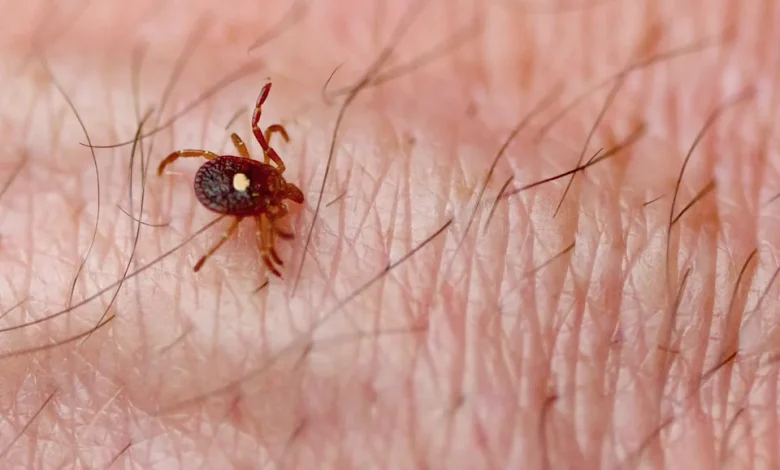First Meat Allergy Death Linked to Tick Bite Raises Public Health Warnings

The first recorded death linked directly to a meat allergy caused by a tick bite has raised serious public health concerns across medical communities worldwide. This rare but increasingly recognized condition—known as Alpha-gal Syndrome (AGS)—has been reported in thousands of cases over the past decade. However, the confirmation of a fatality tied to severe anaphylaxis from the allergy has now placed public health agencies on high alert. As tick populations grow and spread due to climate changes and shifting ecosystems, experts warn that more individuals may be at risk than previously assumed.
The science behind the meat allergy, the role of tick bites, the circumstances surrounding the fatal case, warning signs, prevention strategies, and what public health authorities are recommending.
Understanding Alpha-gal Syndrome: When a Tick Bite Triggers Meat Allergy
Alpha-gal Syndrome (AGS) is a food allergy unlike any other. Instead of reacting to typical allergens such as peanuts or shellfish, individuals with AGS develop an allergy to mammalian meat—including beef, pork, lamb, venison, and products containing red-meat-derived ingredients.
What Causes AGS?
The condition is triggered by a bite from certain tick species. In the United States, the most commonly implicated is the Lone Star Tick (Amblyomma americanum), but cases have been documented with other ticks globally.
When a tick carrying the carbohydrate galactose-α-1,3-galactose, commonly called alpha-gal, bites a human, it transfers this molecule into the bloodstream. The human immune system responds by producing IgE antibodies specific to alpha-gal. Once sensitized, the body identifies the molecule as a threat. Later, when the individual consumes mammalian meat that also contains alpha-gal, the immune system triggers an allergic reaction.
What Makes This Allergy Unique?
- Delayed reactions: Symptoms often appear 2–6 hours after eating meat, making it harder to identify.
- Not lifelong at onset: Some patients lose sensitivity if they avoid further tick bites.
- Severity varies: Reactions can be mild or escalate to full anaphylaxis.
The rising spread of tick populations has brought AGS from an obscure medical curiosity to a rapidly growing public health concern.
The First Recorded Death: What We Know So Far
Health authorities confirmed that an adult patient experienced fatal anaphylaxis after consuming a meal containing beef. Investigators discovered that the individual had undiagnosed Alpha-gal Syndrome triggered by a prior tick bite.
Important Details from the Case
- The victim was unaware of their allergy, despite experiencing mild symptoms in the months leading up to the event.
- The reaction was rapid and severe, progressing to anaphylactic shock before emergency intervention could reverse it.
- Medical personnel confirmed elevated alpha-gal IgE antibodies in lab tests after the incident.
- Tick exposure occurred weeks earlier, likely during outdoor recreational activity.
Until now, AGS had been considered highly disruptive but not fatal when properly managed. The case emphasizes that a lack of diagnosis and continued consumption of mammalian products can be dangerous—and even deadly.
Why This Death Signals a Major Public Health Warning
This unprecedented fatality has prompted public health experts to sound alerts for several reasons:
1. Rising Tick Populations
Warmer temperatures, longer summers, and altered wildlife distribution have contributed to the rapid spread of tick habitats. Regions previously considered low-risk are now reporting cases of AGS and other tick-borne diseases.
2. Underdiagnosis of AGS
Many doctors are unfamiliar with the condition because:
- It was only identified in the last two decades.
- Symptoms mimic other disorders.
- Reactions are delayed, making pattern recognition difficult.
Studies estimate that tens of thousands of people may be living with undiagnosed AGS.
3. Severe Reactions Are More Common Than Believed
While most cases involve hives, swelling, or gastrointestinal distress, a growing number of individuals experience:
- Respiratory difficulty
- Cardiovascular collapse
- Full-body anaphylaxis
The fatal incident confirms that AGS can be deadly if severe and untreated.
4. Increased Consumption of Processed Foods
Alpha-gal is not only present in meat but also in:
- Gelatin
- Dairy products
- Sausage casings
- Some vaccines
- Certain medications (including heart valve implants)
Unidentified exposure raises risks further, especially for those unaware they are allergic.
How a Tick Bite Leads to Life-Threatening Reactions
Ticks can carry a wide range of pathogens, but AGS is unique because it arises from the transfer of a carbohydrate, not a virus or bacteria. The process unfolds as follows:
- Tick feeds on a mammal, absorbing alpha-gal from its blood.
- Tick bites a human, transferring alpha-gal molecules through saliva.
- Human immune system produces IgE antibodies targeting alpha-gal.
- Subsequent consumption of mammalian meat triggers an immune response.
- Massive inflammatory reaction may occur, including anaphylaxis.
The exact biological mechanisms are still being studied, but researchers believe enzymes in tick saliva increase the immunogenicity of alpha-gal.
Symptoms of Alpha-gal Syndrome: What to Watch For
Symptoms typically appear several hours after eating mammalian meat. Common signs include:
Mild to Moderate Symptoms
- Itching or hives
- Swelling of lips, face, or throat
- Gastrointestinal upset (stomach cramps, vomiting, diarrhea)
- Headaches
- Dizziness
Severe Symptoms (Anaphylaxis)
- Difficulty breathing
- Wheezing and chest tightness
- Rapid or weak pulse
- Sudden drop in blood pressure
- Loss of consciousness
If these symptoms develop after consuming meat, especially following a tick bite, medical evaluation is essential.
Diagnosis: How Doctors Identify AGS
Due to the complexity of symptoms, proper diagnosis requires:
- Detailed medical history, including outdoor activity and tick exposure.
- Blood tests measuring alpha-gal specific IgE antibodies.
- Elimination diets to observe changes in symptoms.
Many patients go undiagnosed for months or years, underscoring the need for better clinical awareness.
Treatment Options for Alpha-gal Syndrome
Currently, there is no cure for AGS, but symptoms can be managed effectively with lifestyle adjustments.
1. Avoiding Mammalian Meat
Patients should eliminate:
- Beef
- Pork
- Lamb
- Venison
- Organ meats
2. Identifying Hidden Alpha-gal Sources
The following may also trigger reactions:
- Gelatin-based candies
- Marshmallows
- Meat broths
- Dairy products
- Some medications
3. Emergency Preparedness
Patients diagnosed with AGS should carry:
- Epinephrine auto-injectors
- Antihistamines
- Medical alert identification
4. Avoiding Future Tick Bites
Preventing additional exposures is crucial, as new bites can worsen the allergy.
Public Health Recommendations Following the Fatal Case
Health authorities have issued updated warnings targeting the general public, healthcare providers, and outdoor professionals.
For the General Public
- Wear long sleeves and pants in tick-dense areas.
- Use EPA-approved insect repellents.
- Perform tick checks after hiking or outdoor activities.
- Shower soon after outdoor exposure to remove unattached ticks.
For Healthcare Providers
- Consider AGS when patients report nocturnal allergic reactions after eating.
- Ask about tick exposure during evaluations.
- Educate patients on avoiding hidden alpha-gal sources.
- Report confirmed AGS cases to appropriate health boards.
For Outdoor Workers and Campers
- Treat clothing with permethrin.
- Avoid tall grass and heavily wooded areas.
- Use tick-safe landscaping practices around homes and campsites.
Why Climate Change Is Increasing Concern
Tick populations are booming globally due to:
- Shorter winters
- Expanded habitats
- Higher humidity levels
- Increased deer and rodent populations (primary tick hosts)
As a result, AGS is expected to spread to regions that historically had minimal tick activity.
Global Perspective: AGS in Other Countries
Although AGS gained visibility in the U.S., similar cases are rising in:
- Europe (linked to the castor bean tick)
- Australia (linked to the paralysis tick)
- Asia (various tick species)
The condition is projected to become a more significant worldwide issue in coming years.
What the Fatal Case Means for Future Research
Medical researchers are exploring:
- How different tick species transmit alpha-gal
- Why some individuals develop severe reactions and others do not
- Whether immunotherapy may help reduce sensitivity
- Genetic predispositions that increase risk
The recent fatality has accelerated interest in developing early-screening methods and public health campaigns.
Protecting Yourself: Practical Guide to Prevent Tick Bites
Before Going Outdoors
- Apply DEET-based repellents on exposed skin.
- Treat shoes and clothing with permethrin.
- Choose light-colored clothing to spot ticks easily.
During Outdoor Activity
- Avoid sitting directly on the ground.
- Stay on cleared paths.
- Tuck pants into socks to reduce skin exposure.
After Returning Indoors
- Conduct full-body tick checks.
- Wash clothes in hot water.
- Dry clothes on high heat for at least 10 minutes.
The best defense against AGS is preventing tick exposure altogether.
Conclusion: A Wake-Up Call for Public Awareness
The first confirmed death from a meat allergy triggered by a tick bite marks a turning point in public health awareness. While Alpha-gal Syndrome has been on the rise for years, its potential lethality has now been tragically demonstrated. As tick habitats expand and more individuals unknowingly encounter these arachnids, the importance of prevention, early detection, and public education cannot be overstated.
Understanding the risks, recognizing symptoms, seeking timely diagnosis, and taking preventive measures will be critical in reducing future cases—and saving lives.




